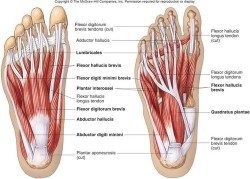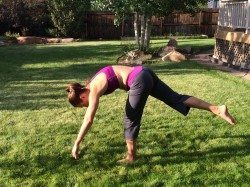Do you know how to TEETER?
I call them “teeters,” short for teeter-totters. Yogis know it as Warrior III or Virabhadrasana. Pilates Instructors teach it as Arabesque. Physical Therapists put it in the category of single leg stance or balance. However you name it, this exercise is packed with about 1000 pounds of goodness. Here are some of the benefits:
-
-
-
- Foot intrinsic activation
- Ankle stability
- Gluteal activation (all THREE of them!)
- Core stability
- Hamstring activation
- Calf and hamstring flexibility
- Balance
- FUNCTION!
-
-
Here is a brief review of the anatomy associated with this movement. The muscles in parentheses have been tested in research via EMG (electromyographic) studies.
Foot intrinsics (quadratus plantae, flexor digitorum brevis, abductor hallicus)
Ankle stability (soleus, gastrocnemius, posterior and anterior tibialis, peroneas longus)
Gluteal (maximus, medius and minimus) and
Hamstring activation (biceps femoris, semimembranosus)
Core Stability
See post on sit-ups to learn more about these muscles
Balance
The vestibular system is stimulated since the eyes are no longer staring at the horizon
FUNCTION (what we do in physical therapy!)
Most of us don’t realize, but we have used this movement to bend over and pick something off the floor. Also, it is a safe movement after back surgery because of the neutral spine position.
TEETERS…see, it’s a lot of bang for your buck! I use it as a rehab exercise with almost every lower extremity condition and teach it almost every week in my core classes (remember: group fitness is preventive PT).
Blog Activity
(please note the list of muscles activated is not all-encompassing, but highlights the groups doing the most work in that position)
Phase I: Single leg balance initiation
- Stand on one leg and stack your shoulders over your hips, lift your ribs away from your hips to engage your body
- Stabilizers activated: transverse abdominus, internal oblique, gluteus medius, soleus, foot intrinsics
Phase II: Tipping of body forward
- Extend your other leg behind you and begin to tip the body forward at the same rate your leg lifts behind you
- Muscles activated: gastrocnemius, ankle stabilizers, gluteus maximus, hamstrings, spinal extensors
Phase III: Control of position at endrange
- At the end of your movement (usually limited by hamstring or calf length and/or balance), hold the position while reaching your leg and arms away from each other
- Muscles activated: everything listed above with an increased focus to the core and gluteus medius
Phase IV: Returning to Phase I
- Initiate your return to Phase I by activating the gluteus maximus (big muscle in back) and tipping the body upright
- Muscles activated: gluteus maximus and hamstrings are working as extensors to pull the body upright.
I called it a TEETER because it should look like a teeter-totter. The trunk should move forward at the same rate the leg is lifting up and back.
What it should look like
What it should NOT look like
Trunk moves more than leg:
Leg moves more than trunk:
Wilting teeter (this is the most common!)
Now do you know how to TEETER? The next time you are performing this exercise, check your form to see if your body is receiving all of the benefits.
© 2014 and Beyond. ALL BLOG CONTENT at duncansportspt.com by Lori Duncan PT









